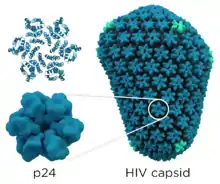
p24 is a component of the HIV particle capsid. There are approximately 2000 molecules per virus particle, or at a molecule weight of 24 kDa, about 104 virus particles per picogram of p24. The onset of symptoms of AIDS correlates with a reduction in the number of CD4+ T cells and increased levels of virus and p24 in the blood.[1] It is a component of the gag polyprotein.
Fourth-generation HIV test
Fourth-generation HIV immunoassays detect viral p24 protein in the blood (as well as patient antibodies against the virus). Previous generation tests relied on detecting patient antibodies alone; it takes about 3–4 weeks for the earliest antibodies to be detected. The p24 protein can be detected in patient blood as early as 2 weeks after HIV infection, further reducing the window period necessary to accurately detect the HIV status of the patient.[2]
See also
References
- ↑ Sharma AK, Gupta GK, Yadav MK, eds. (2022). Medical Microbiology. Berlin Boston: De Gruyter. p. 637. ISBN 978-3-11-051764-4.
- ↑ Constantine N (February 1998). "HIV Antibody Assays". HIV InSite Knowledge Base. Archived from the original on 2001-06-25 – via hivinsite.ucsf.edu.
Further reading
- Wiznerowicz M. "TU vs pg of p24". Trono Lab – Laboratory of Virology and Genetics. École polytechnique fédérale de Lausanne (EPFL). Archived from the original on 9 March 2008.
- "Frequently Asked Questions: Fourth Generation HIV Ab/Ag Combination Assays" (PDF). PA/ MidAtlantic AIDS Education and Training Center at the Health Federation of Philadelphia Last Revised. March 2013. Archived from the original (PDF) on 15 July 2015.